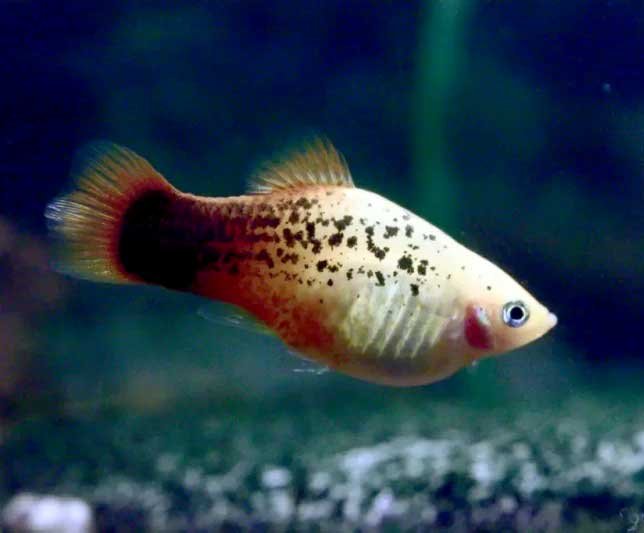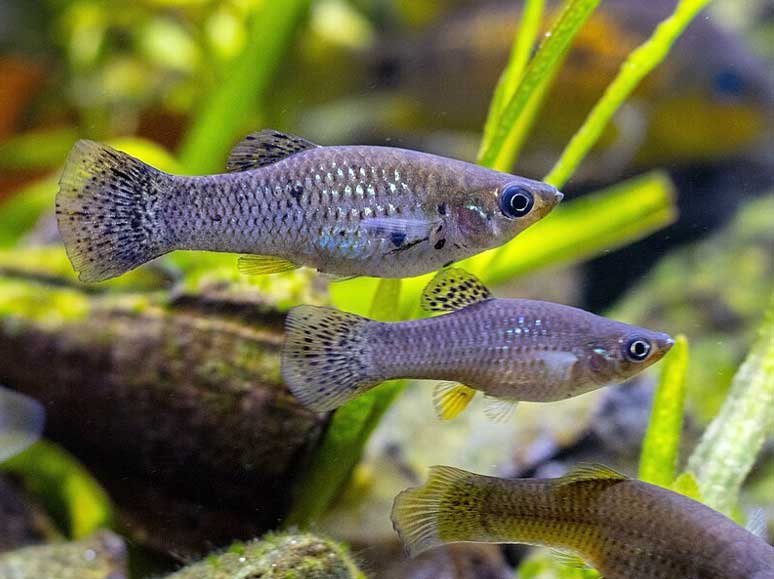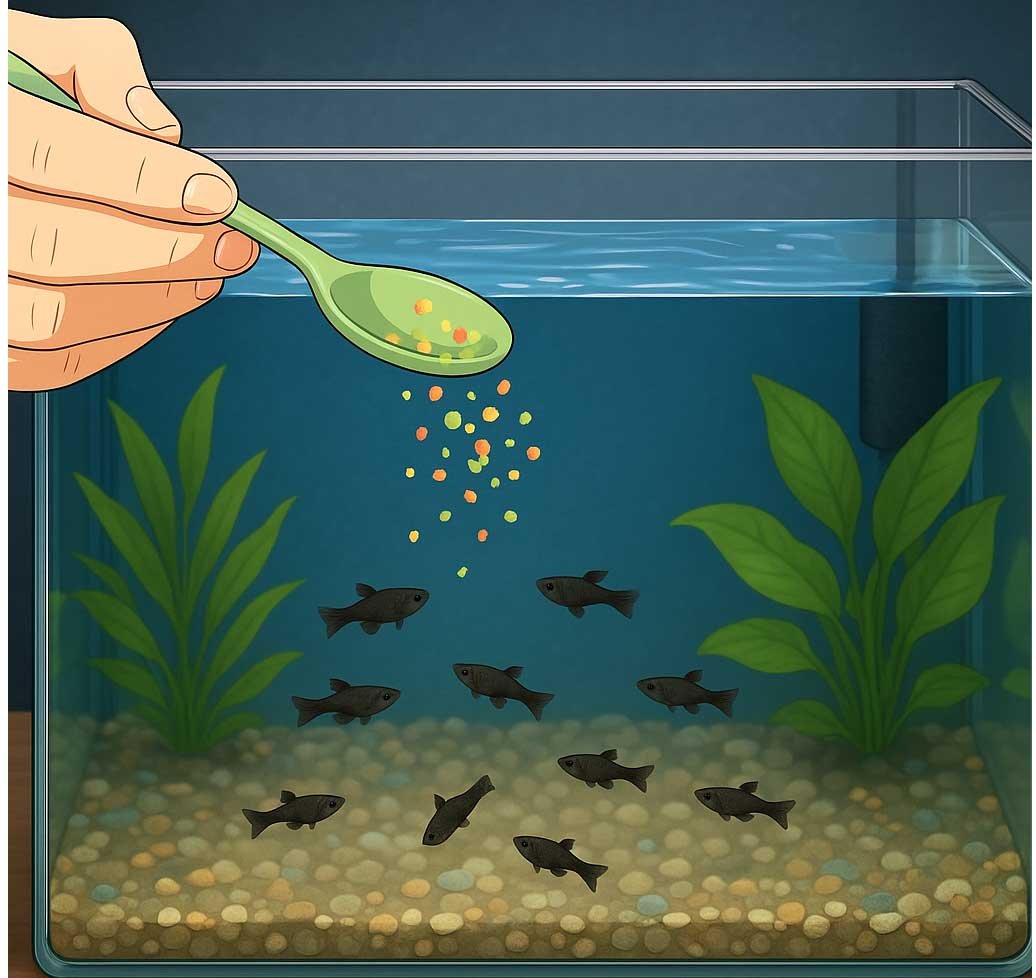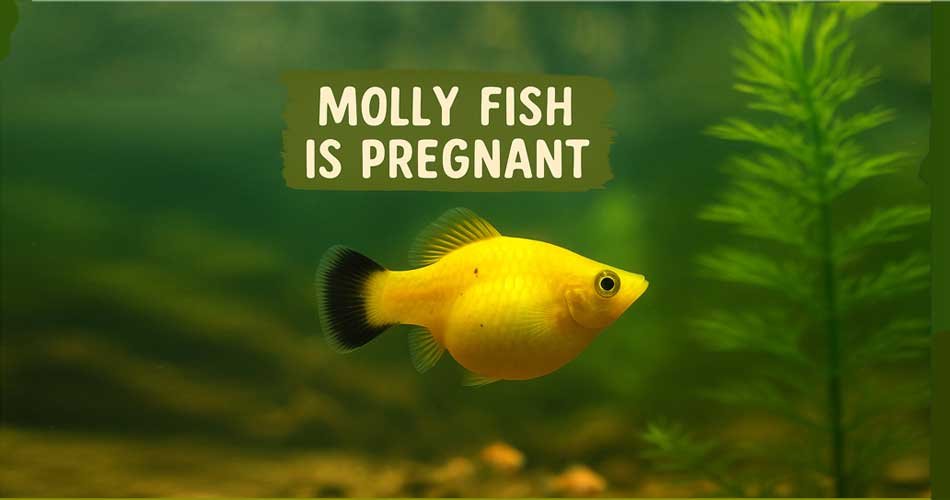How to Tell If My Molly Fish is Pregnant: Key Signs and Tips
Wondering if your Molly fish is pregnant? Look for a few tell-tale signs.
These signs can help you understand your fish’s condition. Molly fish are common in home aquariums. They are livebearers, meaning they give birth to live young. Knowing if your Molly fish is pregnant is important for their care. Pregnant Molly fish need special attention.
This helps ensure the health of both the mother and the baby fish. In this blog post, we will guide you on how to spot pregnancy in Molly fish. We will explain the signs and what to do next. Stay with us to learn more about your Molly fish and ensure they get the best care possible.
Signs Of Pregnancy

Understanding if your Molly fish is pregnant can be an exciting experience. Knowing the signs of pregnancy helps you provide the proper care for your fish. There are several indicators to look for, which can be categorized into behavior changes and physical changes. Observing these signs will help you determine if your Molly fish is expecting.
Behavior Changes
Pregnant Molly fish often show notable behavior changes. These changes can help you identify pregnancy early on. Here are some common behavior changes:
- Isolation: Pregnant Mollys tend to isolate themselves from other fish. They might seek out secluded spots or hide behind plants and decorations.
- Reduced Activity: You might notice your Molly fish becoming less active. They may swim more slowly or rest more often.
- Increased Appetite: Pregnant Mollys often have a bigger appetite. They may eat more frequently or show more interest in food.
- Nesting Behavior: Expectant Mollys sometimes exhibit nesting behavior. They might dig into the substrate or hover near the bottom of the tank.
These behavior changes can be subtle or pronounced, depending on the individual fish. Regular observation is key to noticing these early signs of pregnancy.
Physical Changes
Physical changes are another strong indicator of pregnancy in Molly fish. Here are some physical signs to look out for:
- Swollen Belly: The most obvious sign is a swollen or enlarged belly. As the pregnancy progresses, the belly will become more pronounced.
- Dark Gravid Spot: Pregnant Mollys develop a dark spot near the rear of their abdomen. This spot, known as the gravid spot, becomes more visible as the pregnancy advances.
- Boxy Shape: As the fry grow, the fish’s body shape becomes more boxy. The belly may look squared off from certain angles.
- Visible Fry Eyes: In later stages, you may see tiny eyes of the fry through the thin skin of the mother’s abdomen.
These physical changes become more noticeable as the pregnancy progresses. Monitoring these signs will help you prepare for the arrival of new fry.
Molly Fish Anatomy

Understanding how to tell if your Molly fish is pregnant starts with knowing their anatomy. Molly fish have distinct physical features that help differentiate between males and females. Learning these differences will make it easier to spot pregnancy signs in female Molly fish.
Male Vs. Female
Male and female Molly fish have notable differences in their appearance. Identifying these differences is crucial for recognizing pregnancy in female Molly fish. Here are some key features to look for:
- Size: Female Molly fish are generally larger than males. They have fuller bodies, especially when pregnant.
- Fins: Males have a pointed anal fin called a gonopodium. Females have a fan-shaped anal fin.
- Color: Males often have brighter and more vibrant colors compared to females.
- Behavior: Males are more active and aggressive. They often chase females during mating.
These differences can be summarized in the table below:
| Feature | Male Molly Fish | Female Molly Fish |
|---|---|---|
| Size | Smaller | Larger |
| Anal Fin | Pointed (Gonopodium) | Fan-shaped |
| Color | Brighter | Duller |
| Behavior | Active and Aggressive | Calmer |
Reproductive Organs
Understanding the reproductive organs of Molly fish is essential for identifying pregnancy. Male Molly fish have a specialized anal fin called the gonopodium. The gonopodium is used to fertilize the female’s eggs during mating. This fin is long, pointed, and can be moved to transfer sperm. In contrast, female Molly fish have a fan-shaped anal fin. This fin is not involved in reproduction. Instead, females have a reproductive structure called an ovary, where eggs are produced. Pregnancy signs in female Molly fish include:
- Abdominal enlargement: A swollen belly indicates a developing fry.
- Black gravid spot: A dark spot near the anal fin shows pregnancy.
- Behavior changes: Pregnant females become more reclusive and less active.
These reproductive differences help distinguish between pregnant and non-pregnant females. Observing these signs will assist you in determining if your Molly fish is expecting.
Gestation Period
Wondering if your Molly fish is pregnant? Understanding the gestation period is crucial. This is the time from when the fish becomes pregnant until it gives birth. Knowing how long this period lasts and what affects it can help you prepare for the arrival of new fry.
Duration
The gestation period for Molly fish typically ranges from 20 to 40 days. During this time, the female will carry the developing fry inside her. This duration can vary based on several factors. The average length is about 30 days. Here are some signs to look for during the gestation period:
- Swollen belly
- Dark gravid spot near the anal fin
- Less active behavior
- Hiding more often
Understanding the timeline can help you monitor your fish and ensure they are healthy. Below is a table summarizing the typical duration:
| Stage | Duration (Days) |
|---|---|
| Early Pregnancy | 1-10 |
| Mid Pregnancy | 11-20 |
| Late Pregnancy | 21-30 |
| Possible Extended Period | 31-40 |
Factors Influencing Time
Several factors can influence the gestation period of Molly fish. Water temperature is a significant factor. Warmer water tends to speed up the process, while cooler water can slow it down. Nutrition also plays a crucial role. A well-fed Molly fish with a balanced diet can have a smoother and possibly shorter gestation period. The food should be rich in protein and vitamins. Stress levels are another important factor. A calm and safe environment helps maintain a healthy pregnancy. Stress from overcrowding or aggressive tank mates can prolong the gestation period. Here are some key elements that affect the gestation time:
- Water temperature
- Diet quality
- Stress levels
- Tank conditions
Monitoring these factors can help ensure a successful pregnancy. Keeping the water clean, maintaining a steady temperature, and providing a nutritious diet are essential steps.
Preparing A Breeding Tank

If you suspect your Molly fish is pregnant, creating a special breeding tank is essential. This tank will provide a safe and stress-free environment for the pregnant Molly and her fry (baby fish). The following sections will guide you through setting up the tank and ensuring the right water conditions.
Tank Setup
Setting up a breeding tank for your pregnant Molly fish requires careful planning. You need to consider the tank size, decorations, and necessary equipment. Below are the steps to follow:
- Tank Size: A 10-gallon tank is ideal for breeding. It gives enough space for the pregnant Molly and the fry.
- Filtration: Use a sponge filter. It provides gentle filtration and prevents fry from being sucked in.
- Heater: Maintain a stable temperature. A heater helps keep the water warm and stable.
- Substrate: A bare-bottom tank is easier to clean. It also prevents fry from hiding in the gravel.
- Plants and Hiding Spots: Add live or artificial plants. They provide hiding spots for the fry.
Consider the following table for a quick overview:
| Item | Recommendation |
|---|---|
| Tank Size | 10 gallons |
| Filtration | Sponge filter |
| Heater | Adjustable heater |
| Substrate | Bare bottom |
| Plants | Live or artificial |
Ensure the tank is in a quiet and low-traffic area. This reduces stress for the pregnant Molly. Regular maintenance is also crucial to keep the tank clean and healthy.
Water Conditions
Maintaining the right water conditions is vital for the health of your pregnant Molly and her fry. Here’s what you need to focus on:
- Temperature: Keep the water temperature between 78°F and 82°F. Use an adjustable heater to maintain a stable temperature.
- pH Level: The ideal pH level is between 7.5 and 8.5. Regularly test the water to ensure it stays within this range.
- Ammonia and Nitrite Levels: Both should be at 0 ppm (parts per million). High levels can be harmful to the fry.
- Nitrate Levels: Keep nitrate levels below 20 ppm. Regular water changes help maintain this.
- Hardness: Molly fish prefer hard water. Aim for a hardness level of 15-30 dGH (degrees of General Hardness).
Here’s a quick reference table for water parameters:
| Parameter | Ideal Range |
|---|---|
| Temperature | 78°F – 82°F |
| pH Level | 7.5 – 8.5 |
| Ammonia | 0 ppm |
| Nitrite | 0 ppm |
| Nitrate | < 20 ppm |
| Hardness | 15-30 dGH |
Regularly test the water and perform partial water changes every week. This keeps the environment clean and safe for your Molly and her fry.
Feeding Pregnant Mollies

So, you think your Molly fish might be pregnant? Congratulations! During this special time, feeding your pregnant Molly correctly is essential for her health and the health of her babies. Knowing what to feed and when can make a big difference.
Nutritional Needs
Pregnant Mollies need a balanced diet to ensure they stay healthy and can support their growing fry. Here are some key dietary components:
- Protein: A high-protein diet helps the Molly develop strong, healthy fry. Feed her protein-rich foods like brine shrimp, daphnia, and bloodworms.
- Vegetables: Mollies are omnivores. Include vegetables such as peas, zucchini, and spinach in their diet.
- High-quality flakes: Ensure you use high-quality fish flakes designed for livebearers. These flakes should contain essential vitamins and minerals.
Here’s a simple table to show some recommended foods:
| Food | Type | Feeding Frequency |
|---|---|---|
| Brine Shrimp | Protein | 2-3 times a week |
| Peas | Vegetable | 1-2 times a week |
| Fish Flakes | Staple Diet | Daily |
Remember, variety is key. Mixing different foods ensures your Molly gets all the nutrients she needs. Avoid overfeeding, as this can cause water quality issues and health problems.
Feeding Schedule
Feeding a pregnant Molly requires a consistent schedule to support her nutritional needs without overfeeding. Here’s a recommended feeding routine:
- Morning: Start the day with a small portion of high-quality fish flakes. This gives her energy for the day.
- Midday: Offer a protein-rich food, like brine shrimp or bloodworms. This supports the development of the fry.
- Evening: Provide a small portion of vegetable matter, such as blanched peas or spinach. This helps with digestion.
Here’s a sample daily schedule:
| Time | Food |
|---|---|
| 8:00 AM | Fish Flakes |
| 12:00 PM | Brine Shrimp |
| 6:00 PM | Blanched Peas |
Adjust the schedule based on Molly’s needs. Observe her feeding habits and make sure she eats all the food within a few minutes. If there’s leftover food, reduce the portions to avoid overfeeding. Consistency is crucial. Stick to the routine to ensure your pregnant Molly gets the nutrients she needs to stay healthy and deliver healthy fry.
Signs Of Labor
Is your Molly fish acting strange? Wondering if she’s about to give birth? Knowing the signs of labor can help you prepare. Molly fish show clear signs when they are close to giving birth. Recognizing these signs can ensure a smooth process. Let’s dive into the key behavioral and physical indicators.
Behavioral Cues
Molly fish exhibit distinct behaviors before giving birth. These changes are often easy to spot. Here are some key behavioral cues:
- Restlessness: A pregnant Molly fish may swim erratically. She might dart around the tank or hover near the bottom.
- Isolation: She may separate herself from other fish. Look for her hiding behind plants or decorations.
- Nesting: Molly fish may seek out quiet corners. They prefer secluded spots to give birth.
- Decreased Appetite: A pregnant Molly might eat less. She could ignore food or nibble sparingly.
Monitoring these behaviors can help you anticipate labor. Watch your Molly fish closely during this period. Behavioral changes are often the first signs of labor.
Physical Indicators
Physical signs are just as important as behavioral cues. Here are key physical indicators to watch for:
- Swollen Abdomen: A pregnant Molly fish will have a noticeably larger belly. This is due to the developing fry.
- Dark Gravid Spot: Look for a dark spot near her anal fin. This spot gets darker as labor approaches.
- Boxy Shape: As labor nears, her abdomen may appear boxy. This is different from the usual rounded shape.
- Visible Fry: In some cases, you might see tiny fry through her belly. This indicates she is very close to giving birth.
Tracking these physical changes can help you prepare for the birth. Ensure your tank is ready for the new fry. Physical indicators provide clear evidence of impending labor.
Post-birth Care
When you suspect your Molly fish is pregnant, it’s important to prepare for the arrival of the fry. Post-birth care is crucial for the health and growth of both the mother and her babies. Understanding the right steps to take will ensure a smooth transition for your new fish family.
Fry Care
Taking care of Molly Fry requires attention to detail and patience. These tiny fish need a safe and nurturing environment to thrive.
- Separate the Fry: Molly fry are very small and can be eaten by adult fish. Use a breeder box or a separate tank to keep them safe.
- Feeding: Fry need frequent feedings. Offer them crushed flakes, baby brine shrimp, or specialized fry food. Feed them several times a day to ensure they grow strong.
- Water Quality: Clean water is essential. Perform regular water changes to keep the environment free of toxins.
- Temperature: Maintain a stable water temperature around 78-80°F. Consistent warmth helps fry develop properly.
| Aspect | Details |
|---|---|
| Tank Size | 10 gallons or larger |
| Water Changes | 20-30% weekly |
| Feeding Frequency | 3-4 times daily |
| Temperature | 78-80°F |
Tank Maintenance
Maintaining the tank is vital to ensure a healthy environment for both the mother and the fry.
- Regular Cleaning: Clean the tank regularly. Remove uneaten food and debris to prevent water contamination.
- Water Changes: Perform consistent water changes. Replace 20-30% of the water weekly to keep it fresh.
- Filter Maintenance: Check and clean the filter. A clean filter ensures good water quality and proper oxygen levels.
- Monitor Water Parameters: Keep an eye on pH, ammonia, nitrite, and nitrate levels. Stable water parameters help fish stay healthy.
- Lighting: Provide a consistent light schedule. 8-12 hours of light each day is ideal for fish health.
| Maintenance Task | Frequency |
|---|---|
| Water Changes | Weekly |
| Tank Cleaning | Bi-weekly |
| Filter Check | Monthly |
| Monitor Water Parameters | Weekly |
| Lighting Schedule | Daily |
Common Misconceptions
Have you ever wondered if your Molly fish is pregnant? It’s a common question among fish owners. There are many misconceptions about identifying a pregnant Molly fish. Understanding these can help you take better care of your aquatic friend.
False Pregnancy
One common misconception is that Molly fish can experience false pregnancies. This is not true. Fish do not have the same reproductive systems as mammals. They cannot have false pregnancies. If you think your Molly is pregnant, it’s likely she is. Here are some signs to look for:
- Swollen Belly: A noticeable increase in the size of the belly.
- Gravid Spot: A dark spot near the anal fin. This is where the babies develop.
- Behavior Changes: She may become more reclusive or aggressive.
These signs indicate that your Molly fish is preparing to give birth. Knowing this can help you provide the right care. Make sure she has a safe and comfortable environment.
Myths About Breeding
There are several myths about breeding Molly fish. One myth is that you need a special tank. This is not true. While a breeding tank can be helpful, it is not necessary. A clean and well-maintained tank is enough. Here are some other myths and truths:
| Myth | Truth |
|---|---|
| Molly fish need a male to get pregnant | True. A female Molly needs a male to fertilize her eggs. |
| Molly fish can breed alone | False. They need both male and female fish to breed. |
| Molly fish give birth to hundreds of babies | False. They typically give birth to 20-60 babies at a time. |
Understanding these myths can help you better care for your Molly fish. They need a balanced diet and a clean tank. Avoid overcrowding the tank. This ensures the health of both the mother and her babies. Keeping your fish healthy and happy is the ultimate goal.
Frequently Asked Questions
How To Identify Molly Fish Pregnant?
A pregnant molly fish has a swollen belly and a dark gravid spot near the anal fin. She may also become less active and seek hiding spots.
How Long Is A Mollie’s Pregnancy?
Mollies’ pregnancy lasts approximately 4 to 6 weeks. They can give birth to 20-60 fry at a time.
How Do Pregnant Mollies Act?
Pregnant mollies often become more reclusive and seek privacy. They might swim more slowly and exhibit a rounder belly. Increased appetite is common.
How Do I Know If My Fish Is Pregnant?
Look for a swollen belly, changes in behavior, and a dark spot near the rear fin. Check for nesting behavior and reduced appetite.






